Papers by Mahendra Maharjan
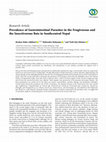
Journal of Parasitology Research
Bats are the only active flying placental mammals and are traditionally classified into mega- and... more Bats are the only active flying placental mammals and are traditionally classified into mega- and microbats, which are, respectively, herbivorous and insectivorous in feeding habit. Though deforestation, habitat destruction, natural calamities, illegal hunting, and climate changes are the challenging threats for bats, the role of existing gastrointestinal (GI) parasites have not been evaluated yet in Nepal. Thus, the current study aims to determine the prevalence of GI parasites in bats from the Shaktikhor area at the Chitwan district of Southcentral Nepal. From July 2018 to February 2019, a total of 60 fecal samples of bats (30 from frugivorous bats and 30 from the insectivorous bats) were collected. These samples were preserved at 2.5% potassium dichromate solution. The fecal examination was carried out by the direct wet mount, concentrations, acid-fast staining, and sporulation techniques. Overall results showed the prevalence rate of 80% GI parasites. The parasites detected in t...
International Journal of Infectious Diseases
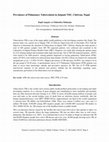
Nepalese Journal of Zoology
Tuberculosis (TB) is one of the major public health problems in the developing countries like Nep... more Tuberculosis (TB) is one of the major public health problems in the developing countries like Nepal. The present study was carried out in Jutpani VDC of Chitwan Nepal from July to December 2012 with the objective to determine the situation of Tuberculosis in Jutpani VDC, Chitwan. During the study period, a total of 600 sputum samples from 200 TB suspected patients were collected and examined in the Laboratory of Jutpani Primary Health Center (PHC). Diagnosis was made after staining the sputum smear by Z-N staining method and examined under light microscope. Out of 200 TB suspected patients, 18(9%) were found to be AFB positive. Among patients diagnosed as having pulmonary Tuberculosis (PTB), males (55.56%) were found to be infected more than females (44.44%) which was found to be statistically insignificant (Χ2cal. = 0.4524, P<0.01). Highest prevalence of TB infection (36.89%) was found to be in the age group of 30-40 years. A questionnaire survey of 57 Pulmonary Tuberculosis (PT...
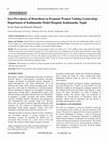
National Journal of Health Sciences
Introduction: Brucellosis is a highly contagious zoonotic disease caused by ingestion of unpasteu... more Introduction: Brucellosis is a highly contagious zoonotic disease caused by ingestion of unpasteurized milk or undercooked meat from infected animals or close contact with their secretions. Subject and Methods: Sero-prevalence of brucellosis in pregnant women was conducted for the first time in Kathmandu, Nepal. A total of 80 sera samples were collected from the pregnant women visiting Kathmandu Model Hospital. The patients were categorized on the basis of age, trimester and ethnic groups. The sera samples were tested by ELISA method. Results: The sero-prevalence of brucellosis among pregnant women was found to be 11.25%. Madhesi ethnic group showed the highest (16.66%) seropositivity rates followed by Janajati (11.53%) and the lowest was in Brahmin (8.33%) ethnic group. Similarly, the age group 31-35 years showed highest prevalence (29.41%) followed by the age group 26-30 years (13.33%). There is absence of seropositivity among the age group 16-20 years and 21-25 years. The highest sero-prevalence rate (12.76%) was found in the third trimester followed by first trimester (10%) and the lowest was in second trimester (8.69%). About 3% of them consume raw milk directly from milking animals which is one of the risk factor of brucellosis in pregnant women. Conclusion: The prevalence was found to be high in pregnant women and ELISA was a sensitive and specific test for the detection of IgG antibodies against Brucella.
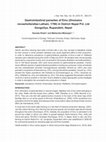
Journal of Natural History Museum
Ostrich and Emu farming have been lunched with a very new concept to Nepalese market for their pr... more Ostrich and Emu farming have been lunched with a very new concept to Nepalese market for their product in which parasitic diseases may cause significant effect to their production. In order to determine prevalence of gastrointestinal parasites of Emu, a total of 100faecalsamples were collected during the month of May/July 2015. All samples were microscopically examined by using direct smear and concentration techniques (floatation and sedimentation).Out of 100 faecal samples, 65% were found positive for gastrointestinal parasites. Overall, seven different species of gastrointestinal parasites including two protozoan, three nematodes and two cestodes were recorded. Amongprotozoan parasites, Eimeria sp. (30%) was more prevalent compared to Entamoeba sp.(10%). Among helminthes parasites, Ascaris sp. (15%)showed the higher prevalence rate followed by Dromaestrogylus sp. (10%), Davainea sp.(9%), Raillietina sp. (5%) and Heterakis sp. (5%). This study suggested that parasitic infection co...
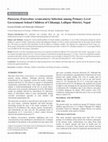
National Journal of Health Sciences
Introduction: Poor sanitation and crowding effect are easy way for transmission of enterobiasis b... more Introduction: Poor sanitation and crowding effect are easy way for transmission of enterobiasis between infected and uninfected person and it is usually common among playgroup and school kids. Subject and Methods: Among the various health problem of school children, enterobiasis is one of them still present among the school children in context of Nepal. Unawareness along with unhygienic lifestyle as well as crowdy environment may be the major reasons behind this. This study was aimed to find enterobiasis of school children in Chhampi, Lalitpur. The students were categorized on basis of age, sex, ethnic group, itching habit, nail biting habit and playing with domestic pets habit. A total of 107 cellophane samples of 2-13 years aged children were included for the microscopic examination. Result: Overall 11(10.28%) enterobiasis prevalence were reported in children including 10.91% male and 9.26% female. Age group 5-7 years was found to be highly infected (4.67%). There was absence of enterobiasis among the age group 11-13 years. There was insignificant statistics association ethnically with the enterobiasis however the prevalence rate was higher in Janajati (54.54%). There were no significant association between pinworm infection with scratching habit around anus (P > 0.05) and nail biting habit (P > 0.05) of children. Conclusion: The prevalence was found to be high among primary level children and Scotch tape was a specific test for the detection of eggs of pinworm against enterobiasis.
Zootaxa
The purpose of this study was to record the species of chewing lice parasitising Gyps bengalensis... more The purpose of this study was to record the species of chewing lice parasitising Gyps bengalensis (Gmelin, 1788), the white-rumped vulture, in Pithauli, Nawalparasi District, Nepal, from February to June 2017. Three louse species were identified: Cuculiphilus (Aegypiphilus) gypsis (Eichler, 1944), Colpocephalum sp., and the new species Aegypoecus bengalensis, described herein.
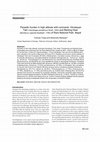
Nepal Journal of Environmental Science
Parasites of two high altitude ruminants Himalayan Tahr (Near Threatened) and Barking Deer (Vulne... more Parasites of two high altitude ruminants Himalayan Tahr (Near Threatened) and Barking Deer (Vulnerable) were examined from the Rara National Park, located at 3000 – 4000 m altitude of Nepal, for the first time. A total of 51 faecal samples, 17 from Himalayan Tahr and 34 from Barking Deer were collected in the month of May/June 2012 and 2013. Parasites were found in all the samples of Himalayan Tahr and 33 samples (97.06%) of Barking Deer. Coccidian oocysts (Eimeria sp.), eggs of cestodes (Moniezia sp.) and gastrointestinal nematodes (Strongyloides sp., Trichuris sp., Oxyuris sp., Ascaris sp., Trichostrongylus sp. and Haemonchus sp.) and bronchopulmonary nematode larvae (Dictyocaulus sp. and Muellerius sp.) were identified by means of coprological techniques. Himalayan Tahrs were found to be highly infected with Eimeria sp. (88.24%) and Moniezia sp. (70.59%) compared to Barking Deers, Eimeria sp. (73.53%) and Moniezia sp. (47.06%). In Himalayan Tahr, prevalence of Oxyuris was found t...
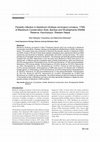
Nepal Journal of Environmental Sciences
Blackbuck (Antilope cervicapra) is Near Threatened species which are conserved in blackbuck Conse... more Blackbuck (Antilope cervicapra) is Near Threatened species which are conserved in blackbuck Conservation Area (BCA), Khairapur, Bardiya and Shuklaphanta Wildlife Reserve (SWR), Kanchanpur district. The present study was conducted to determine the parasitic infection in blackbuck of BCA and SWR. A total of 150 and 70 fresh faecal samples of blackbuck were collected from BCA and SWR respectively and examined by floatation, sedimentation and Stoll's counting technique. The overall prevalence of GI parasites was found to be 90.00%. The protozoan and helminthic parasitic prevalence revealed 55% and 89% respectively in both the study area. Blackbuck of BCA were found to be infected with 12 different species of parasites which includes Entamoeba sp. (20%) and Eimeria sp. (45.33%) among protozoa; Paramphistomum sp. (25.33%) and Fasciola sp. (17.33%) among trematodes; Moniezia sp. (14%) among cestode; Trichostrongylus sp. (75.33%), Ascaris sp. (57.33%), Haemonchus sp. (18%), Strongyloide...

Journal of Natural History Museum
A total of 22 faecal samples of Red panda were collected in the month of May/June 2011 and 21 fae... more A total of 22 faecal samples of Red panda were collected in the month of May/June 2011 and 21 faecal samples from the same site during the month of May/June 2012. All the samples were microscopically examined by faecal floatation and sedimentation techniques. Out of 43 faecal samples, 40 samples (93.02%) were found positive for gastro-intestinal parasites. Altogether, 12 different species of gastro-intestinal parasites were recovered from Red panda. Among them, two species of protozoan parasites and 10 species of helminthes were observed. In protozoan parasites, Eimeria (67.44%) was more prevalent as compared to Entamoeba (62.79%). Among helminthes, Oxyuris sp. showed the highest prevalence rate followed by Toxoascaris sp. (48.84%), Hookworm (44.19%), Baylisascaris sp., Crenosoma sp. (34.88%), Strongyloides sp., Moniezia sp. (18.60%), Trichuris sp., etastrongylus sp. (4.65%) and Angiostrongylus sp. (2.33%). Only one species of cestoda i.e. Moniezia sp. was found but trematodes and a...
Ticks and tick-borne diseases, Jan 30, 2018
Males and females specimens of Amblyomma were collected from Orthriophis hodgsoni (Squamata: Colu... more Males and females specimens of Amblyomma were collected from Orthriophis hodgsoni (Squamata: Colubridae) caught during routine herpetological work in Kathmandu. Morphological characteristics led to the diagnosis of A. varanense, constituting the second Nepalese species for the genus after the collection of Amblyomma gervaisi, also from a colubrid snake, almost 100 years ago. Amblyomma varanense is the 55th species found in the country, and preceded for the collection of 21 species of Haemaphysalis, 14 Ixodes, 6 Rhipicephalus, 6 Hyalomma, 4 Dermacentor, 1 Amblyomma, 1 Anomalohimalaya and 1 species of Nosomma. Eleven and 19 species have been found on humans and domestic mammals, respectively, evidencing the medical and economic importance of Nepalese Ixodidae.
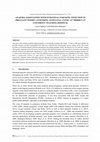
Journal of Advanced College of Engineering and Management
Anaemia is the common problem during pregnancy in developing countries like Nepal. A total of 20... more Anaemia is the common problem during pregnancy in developing countries like Nepal. A total of 200 stool samples for parasitic infection and their haemoglobin level data were collected from the pregnant women visiting TUTH. The overall prevalence of intestinal parasitic infection and anaemic rate among pregnant women was found to be 35% and 50%. Among 100 anaemic pregnant women 58 women were infected with intestinal parasites. The association of anaemia with intestinal parasitic infection was statistically significant (P > 0.05). The most dominant parasite among anaemic pregnant women was A. lumbricoides followed by H. nana. Total five different types of intestinal parasites were identified in this study. Among them A. lumbricoides (30.5%), H. nana 6(3%), E. histolytica 5(2.5%), T. trichiura 2(%) and S. stercoralis 2(1%) respectively. Pregnant women with single parasitic infection were found to be 64(32%) and multiple infection were 6(3%). Intensity of parasitic infection found t...

Nepal Journal of Biotechnology, 2016
&amp;amp;amp;amp;amp;amp;amp;amp;amp;amp;amp;amp;amp;amp;amp;amp;amp;amp;amp;amp;amp;amp;amp;... more &amp;amp;amp;amp;amp;amp;amp;amp;amp;amp;amp;amp;amp;amp;amp;amp;amp;amp;amp;amp;amp;amp;amp;amp;amp;amp;amp;amp;amp;amp;amp;amp;amp;amp;amp;amp;amp;amp;amp;amp;amp;amp;amp;amp;amp;amp;amp;amp;amp;amp;amp;amp;amp;amp;amp;amp;amp;amp;amp;amp;amp;amp;amp;amp;amp;amp;amp;amp;amp;amp;amp;amp;amp;amp;amp;amp;amp;amp;amp;amp;amp;amp;amp;amp;amp;amp;amp;amp;amp;amp;amp;amp;amp;lt;p&amp;amp;amp;amp;amp;amp;amp;amp;amp;amp;amp;amp;amp;amp;amp;amp;amp;amp;amp;amp;amp;amp;amp;amp;amp;amp;amp;amp;amp;amp;amp;amp;amp;amp;amp;amp;amp;amp;amp;amp;amp;amp;amp;amp;amp;amp;amp;amp;amp;amp;amp;amp;amp;amp;amp;amp;amp;amp;amp;amp;amp;amp;amp;amp;amp;amp;amp;amp;amp;amp;amp;amp;amp;amp;amp;amp;amp;amp;amp;amp;amp;amp;amp;amp;amp;amp;amp;amp;amp;amp;amp;amp;amp;gt;Failure of antimonial drugs, the mainstay therapy for leishmaniasis has become an escalating problem in the treatment of Indian leishmaniasis. Using 14 clinical isolates from both visceral (VL) and post-kala-azar dermal leismaniasis (PKDL) patients, we have examined the role of ATP-binding cassette transporter (ABC transporter) gene, multidrug resistant protein A (MRPA) and two building blocks of the major thiol, trypanothione namely, ornithine decarboxylase gene (ODC) (a rate limiting enzyme in the polyamine biosynthesis) and γ-glutamylcysteine synthetase (γ-GCS) (a rate limiting enzyme in glutathione biosynthesis) in antimony resistance. Amplification of these three genes was observed in some but not all clinical isolates. Increased expression of the three RNAs as determined by real-time PCR was observed in all SAG-R clinical isolates. Significant increase in cysteine and glutathione levels was observed in the resistant isolates. Our studies report the underlying mechanism of antimony resistance in the clinical isolates.&amp;amp;amp;amp;amp;amp;amp;amp;amp;amp;amp;amp;amp;amp;amp;amp;amp;amp;amp;amp;amp;amp;amp;amp;amp;amp;amp;amp;amp;amp;amp;amp;amp;amp;amp;amp;amp;amp;amp;amp;amp;amp;amp;amp;amp;amp;amp;amp;amp;amp;amp;amp;amp;amp;amp;amp;amp;amp;amp;amp;amp;amp;amp;amp;amp;amp;amp;amp;amp;amp;amp;amp;amp;amp;amp;amp;amp;amp;amp;amp;amp;amp;amp;amp;amp;amp;amp;amp;amp;amp;amp;amp;amp;lt;/p&amp;amp;amp;amp;amp;amp;amp;amp;amp;amp;amp;amp;amp;amp;amp;amp;amp;amp;amp;amp;amp;amp;amp;amp;amp;amp;amp;amp;amp;amp;amp;amp;amp;amp;amp;amp;amp;amp;amp;amp;amp;amp;amp;amp;amp;amp;amp;amp;amp;amp;amp;amp;amp;amp;amp;amp;amp;amp;amp;amp;amp;amp;amp;amp;amp;amp;amp;amp;amp;amp;amp;amp;amp;amp;amp;amp;amp;amp;amp;amp;amp;amp;amp;amp;amp;amp;amp;amp;amp;amp;amp;amp;amp;gt;

ABSTRACT on the health of expected mother and developing baby. In order to assess the association... more ABSTRACT on the health of expected mother and developing baby. In order to assess the association between anaemia and parasitic infection during pregnancy, a total of 200 stool samples from pregnant women on their first consultation to antenatal service in Koshi Zonal Hospital were collected from April to August 2012. The stool samples were examined for intestinal parasites by direct smear technique, while haemoglobin level of pregnant women were collected from laboratory record of the hospital. Out of 110 anaemic pregnant women 40(36.3%) had parasitic infection, while from 90 non-anaemic pregnant women; only 18(20%) of them were infected with intestinal parasites. The association of anaemia with intestinal parasite was statistically significant (p&lt;0.008). The prevalence of Hookworm (76.9%) was most prevalent infection followed by Ascaris lumbricoides (73.3%) in anaemic pregnant women. The mean Haemoglobin (Hb) level of pregnant women with single parasite and with multiple infection was 10.4 ± 1.80 gm/dl (mild anaemia) and 9.81 ± 0.84 gm/dl (moderate anaemia) respectively. However, the overall prevalence of the parasitic infection among pregnant women was 58(29%). A. lumbricoides (32.3%) was the most predominant followed by Hookworm (26.1%), Giardia lamblia (21.5%), Entamoeba histolytica (10.7%), Trichuris trichiura (6.15%), Strongyloides stercoralis (1.5%) and Hymenolepis nana (1.5%). An integrated programme for the control of this parasitic infection should be regarded as an issue of public health priority in order to reduce the degree of anaemia during pregnancy.

ABSTRACT The present study has been carried out on school children of Everest English School and ... more ABSTRACT The present study has been carried out on school children of Everest English School and Prabhat English Higher Secondary School of Bhaktapur District, Nepal from June 2011 to March 2012 in order to determine the prevalence of intestinal helminthes. A total of 495 stool samples from the children of two schools were examined by direct smear method under microscope. Among them, 137 (27.67%) were found positive for one or more intestinal helminth parasites. Ascaris lumbricoides (22.63%) showed highest prevalence followed by Trichuris trichiura (6.06%), Strongyloides stercoralis (1.82%), Hookworm (1.62%), Taenia sp. (1.01%), Hymenolepis nana (0.81%) and Enterobius vermicularis (0.40%). The helminthic infection was found to be almost equal in male and female children and statistically no significant difference was found (χ2 = 8.31×10-6, p&gt;0.05). Out of 137 positive cases, 78.83% were infected with single parasites. Double and multiple infections were found among 18.98% and 2.19% of students respectively. The occurrence of intestinal helminth parasites may be attributed to unhygienic way of life, poverty, ignorance and poor sanitation.

Uploads
Papers by Mahendra Maharjan